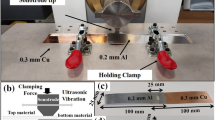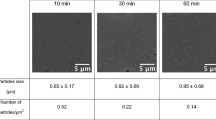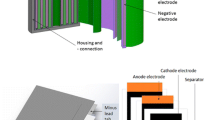Abstract
The fabrication of lightweight components has been at the forefront of technological advancements in present-day electrical vehicle components. However, the use of ultra-thin AA1050 sheet materials for critical battery components, such as cooling plates, remains a challenge due to the need for adequate joining techniques. This paper investigated the reliability of joining these sheets using laser welding with the wobbling technique. The primary aim was to understand the effect of wobbling on the porosity formation and investigation of the weld properties and morphology. In this regard, response surface methodology (RSM) was used to optimise the laser welding process parameters and to maximise the responses in terms of lap shear strength, interface width and area (%) of porosities present in the joint. The analysis of variance was used to obtain a set of optimised input parameters affecting the strength and morphology of the weld, and these were welding speed of 2000 mm/min, laser power of 300 W, and wobbling amplitude of 0.6 mm. Furthermore, the use of the wobbling technique resulted in uniform distribution of heat input thereby leading to the refinement of the equiaxed grains and augmented the weld’s microhardness. A comprehensive analysis of the effect of wobbling on the porosity formation in joining the ultra-thin sheets was presented for a better understanding.















Similar content being viewed by others
References
Shrivastava R, Neeta S, Geeta G (2013) Air pollution due to road transportation in India: a review on assessment and reduction strategies. Journal of Environmental Research And Development 8:69–77
Previati G, Mastinu G, Gobbi M (2022) Thermal management of electrified vehicles—a review. Energies (Basel) 15. https://doi.org/10.3390/en15041326
Spotnitz R, Franklin J (2003) Abuse behavior of high-power, lithium-ion cells. J Power Sources 113:81–100. https://doi.org/10.1016/S0378-7753(02)00488-3
Sudarsan C, Sajun Prasad K, Hazra S, Panda SK (2020) Forming of serpentine micro-channels on SS304 and AA1050 ultra-thin metallic sheets using stamping technology. J Manuf Process 56:1099–1113. https://doi.org/10.1016/j.jmapro.2020.05.013
Pryor L, Schlobohm R, Brownell B (2008) A comparison of aluminum vs . copper as used in electrical equipment. Corrosion, pp 1–7
Sakai T, Okamoto S, Iikawa T et al (1987) A new laser hermetic sealing technique for aluminum package. IEEE Transactions on Components, Hybrids, and Manufacturing Technology 10:433–436. https://doi.org/10.1109/TCHMT.1987.1134768
Kumar N, Das A, Dale T, Masters I (2021) Laser wobble welding of fluid-based cooling channel joining for battery thermal management. J Manuf Process 67:151–169. https://doi.org/10.1016/j.jmapro.2021.04.064
Kumar N, Masters I, Das A (2021) In-depth evaluation of laser-welded similar and dissimilar material tab-to-busbar electrical interconnects for electric vehicle battery pack. J Manuf Process 70:78–96. https://doi.org/10.1016/j.jmapro.2021.08.025
Shen J, Agrawal P, Rodrigues TA et al (2022) Gas tungsten arc welding of as-cast AlCoCrFeNi2.1 eutectic high entropy alloy. Mater Des 223. https://doi.org/10.1016/j.matdes.2022.111176
Shen J, Agrawal P, Rodrigues TA et al (2023) Microstructure evolution and mechanical properties in a gas tungsten arc welded Fe42Mn28Co10Cr15Si5 metastable high entropy alloy. Mater Sci Eng A 867. https://doi.org/10.1016/j.msea.2023.144722
Zhang W, Ao S, Oliveira JP et al (2020) On the metallurgical joining mechanism during ultrasonic spot welding of NiTi using a Cu interlayer. Scr Mater 178:414–417. https://doi.org/10.1016/j.scriptamat.2019.12.012
Zhang W, Ao SS, Oliveira JP, et al (2018) Corrigendum: Effect of ultrasonic spot welding on the mechanical behaviour of NiTi shape memory alloys (Smart Materials and Structures(2018) 27 (085020) DOI: 10.1088/1361-665X/aacfeb). Smart Mater Struct 27
Pamarthi VV, Sun T, Das A, Franciosa P (2023) Tailoring the weld microstructure to prevent solidification cracking in remote laser welding of AA6005 aluminium alloys using adjustable ringmode beam. J Maters Res Technol 25:7154–7168. https://doi.org/10.1016/j.jmrt.2023.07.154
Rodriguez P (1997) Selection of Materials for Heat Exchangers. Heb 97:1–72
Chen W, Molian P (2008) Dual-beam laser welding of ultra-thin AA 5052-H19 aluminum. Int J Adv Manuf Technol 39:889–897. https://doi.org/10.1007/s00170-007-1278-3
Luangpaiboon P (2011) Constrained response surface optimization for a laser beam welding process. J Math Stat 7:5–11. https://doi.org/10.3844/jmssp.2011.5.11
Das A, Butterworth I, Masters I, Williams D (2018) Microstructure and mechanical properties of gap-bridged remote laser welded (RLW) automotive grade AA 5182 joints. Mater Charact 145:697–712. https://doi.org/10.1016/j.matchar.2018.09.035
Stavridis J, Papacharalampopoulos A, Stavropoulos P (2018) Quality assessment in laser welding: a critical review. Int J Adv Manuf Technol 94:1825–1847
Seto N, Katayama S, Matsunawa A (2001) Porosity formation mechanism and suppression procedure in laser welding of aluminium alloys. Weld Int 15:191–202. https://doi.org/10.1080/09507110109549341
Berend O, Haferkamp H, Meier O, Engelbrecht L (2005) High-frequency beam oscillating to increase the process stability during laser welding with high melt pool dynamics. 24th International Congress on Applications of Lasers and Electro-Optics, ICALEO 2005 - Congress Proceedings 2206:1032–1041. https://doi.org/10.2351/1.5060476
Alshaer AW, Li L, Mistry A (2015) Understanding the effect of heat input and sheet gap on porosity formation in fillet edge and flange couch laser welding of AC-170PX aluminum alloy for automotive component manufacture. Journal of Manufacturing Science and Engineering, Transactions of the ASME 137:1–14. https://doi.org/10.1115/1.4028900
Bayat M, Thanki A, Mohanty S et al (2019) Keyhole-induced porosities in laser-based powder bed fusion (L-PBF) of Ti6Al4V: high-fidelity modelling and experimental validation. Addit Manuf 30:100835. https://doi.org/10.1016/j.addma.2019.100835
Manladan SM, Yusof F, Ramesh S et al (2017) A review on resistance spot welding of aluminum alloys. Int J Adv Manuf Technol 90:605–634
Kuryntsev SV, Gilmutdinov AK (2015) The effect of laser beam wobbling mode in welding process for structural steels. Int J Adv Manuf Technol 81:1683–1691. https://doi.org/10.1007/s00170-015-7312-y
Tan Z, Pang B, Oliveira JP et al (2022) Effect of S-curve laser power for power distribution control on laser oscillating welding of 5A06 aluminum alloy. Opt Laser Technol 149. https://doi.org/10.1016/j.optlastec.2022.107909
Wang X, Zhang Z, Zhang Q et al (2021) Effects of laser oscillation on fluid flow in weld pool and macrosegregation mitigation during laser welding of Al-Si coated press-hardened steels. Opt Laser Technol 143:107387. https://doi.org/10.1016/j.optlastec.2021.107387
Zhou J, Zhou D, Liu J (2022) Effect of oscillating laser beam on the interface and mechanical properties of Ti/Al fusion welding joint. Journal of Materials Research and Technology 19:1993–2007. https://doi.org/10.1016/j.jmrt.2022.05.162
Fetzer F, Sommer M, Weber R et al (2018) Reduction of pores by means of laser beam oscillation during remote welding of AlMgSi. Opt Lasers Eng 108:68–77. https://doi.org/10.1016/j.optlaseng.2018.04.012
Das A, Li D, Williams D, Greenwood D (2019) Weldability and shear strength feasibility study for automotive electric vehicle battery tab interconnects. J Braz Soc Mech Sci Eng 41:1–14. https://doi.org/10.1007/s40430-018-1542-5
Bezerra MA, Santelli RE, Oliveira EP et al (2008) Response surface methodology (RSM) as a tool for optimization in analytical chemistry. Talanta 76:965–977. https://doi.org/10.1016/j.talanta.2008.05.019
Courtois M, Carin M, Le Masson P et al (2014) A complete model of keyhole and melt pool dynamics to analyze instabilities and collapse during laser welding. J Laser Appl 26:042001. https://doi.org/10.2351/1.4886835
Barbieri G, Cognini F, Moncada M et al (2017) Welding of automotive aluminum alloys by laser wobbling processing. Mater Sci Forum 879:1057–1062. https://doi.org/10.4028/www.scientific.net/MSF.879.1057
Bunaziv I, Frostevarg J, Ren X et al (2019) Porosity and solidification cracking in welded 45 mm thick steel by fiber laser-MAG process. Procedia Manuf 36:101–111. https://doi.org/10.1016/j.promfg.2019.08.015
Chen L, Wang C, Mi G, Zhang X (2021) Effects of laser oscillating frequency on energy distribution, molten pool morphology and grain structure of AA6061/AA5182 aluminum alloys lap welding. Journal of Materials Research and Technology 15:3133–3148. https://doi.org/10.1016/j.jmrt.2021.09.141
Li S, Mi G, Wang C (2020) A study on laser beam oscillating welding characteristics for the 5083 aluminum alloy: morphology, microstructure and mechanical properties. J Manuf Process 53:12–20. https://doi.org/10.1016/j.jmapro.2020.01.018
Chowdhury SM, Chen DL, Bhole SD et al (2011) Microstructure and mechanical properties of fiber-laser-welded and diode-laser-welded AZ31 magnesium alloy. Metall Mater Trans A Phys Metall Mater Sci 42:1974–1989. https://doi.org/10.1007/s11661-010-0574-y
Coniglio N, Cross CE (2013) Initiation and growth mechanisms for weld solidification cracking. Int Mater Rev 58:375–397
Mohan A, Franciosa P, Ceglarek D, Auinger M (2022) Numerical simulation of transport phenomena and its effect on the weld profile and solute distribution during laser welding of dissimilar aluminium alloys with and without beam oscillation. Int J Adv Manuf Technol 3311–3325. https://doi.org/10.1007/s00170-022-10623-3
Kou S (2003) Welding Metallurgy, Second ed. John Wiley & Sons, Inc., Hoboken, New Jersey
Eskin DG, Katgerman L (2006) Thermal contraction during solidification of aluminium alloys. In: Materials science forum. Trans Tech Publications Ltd, pp 1681–1686
Yuan T, Luo Z, Kou S (2016) Grain refining of magnesium welds by arc oscillation. Acta Mater 116:166–176. https://doi.org/10.1016/j.actamat.2016.06.036
Harooni M, Carlson B, Strohmeier BR, Kovacevic R (2014) Pore formation mechanism and its mitigation in laser welding of AZ31B magnesium alloy in lap joint configuration. Mater Des 58:265–276. https://doi.org/10.1016/j.matdes.2014.01.050
Torabi A, Kolahan F (2018) Optimizing pulsed Nd:YAG laser beam welding process parameters to attain maximum ultimate tensile strength for thin AISI316L sheet using response surface methodology and simulated annealing algorithm. Opt Laser Technol 103:300–310. https://doi.org/10.1016/j.optlastec.2017.12.042
Author information
Authors and Affiliations
Contributions
P. V. V.: conceptualisation, methodology, experimental investigations, software validation, visualisation, preparation of manuscript, and editing. C. S.: formal analysis, visualisation, and manuscript editing and reviewing. A. D.: investigation, data curation, resources, reviewing, and supervision. S. H. and S. K. P.: resources, manuscript review, editing, and supervision.
Corresponding author
Ethics declarations
Ethics approval
This is not applicable
Consent to participate
This is not applicable
Consent for publication
This is not applicable
Competing interests
The authors declare no competing interests.
Additional information
Publisher’s Note
Springer Nature remains neutral with regard to jurisdictional claims in published maps and institutional affiliations.
Rights and permissions
Springer Nature or its licensor (e.g. a society or other partner) holds exclusive rights to this article under a publishing agreement with the author(s) or other rightsholder(s); author self-archiving of the accepted manuscript version of this article is solely governed by the terms of such publishing agreement and applicable law.
About this article
Cite this article
Pamarthi, V.V., Sudarsan, C., Das, A. et al. Study of beam wobbling technique and porosity formation in laser welding of ultra-thin AA1050 sheet—microstructural and mechanical analysis. Int J Adv Manuf Technol 129, 4011–4029 (2023). https://doi.org/10.1007/s00170-023-12493-9
Received:
Accepted:
Published:
Issue Date:
DOI: https://doi.org/10.1007/s00170-023-12493-9




